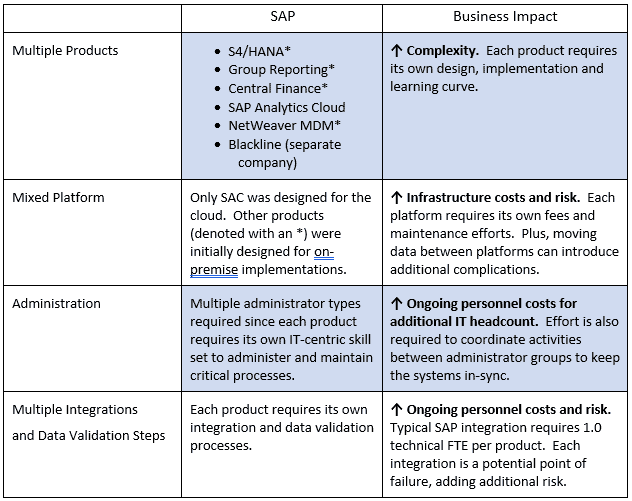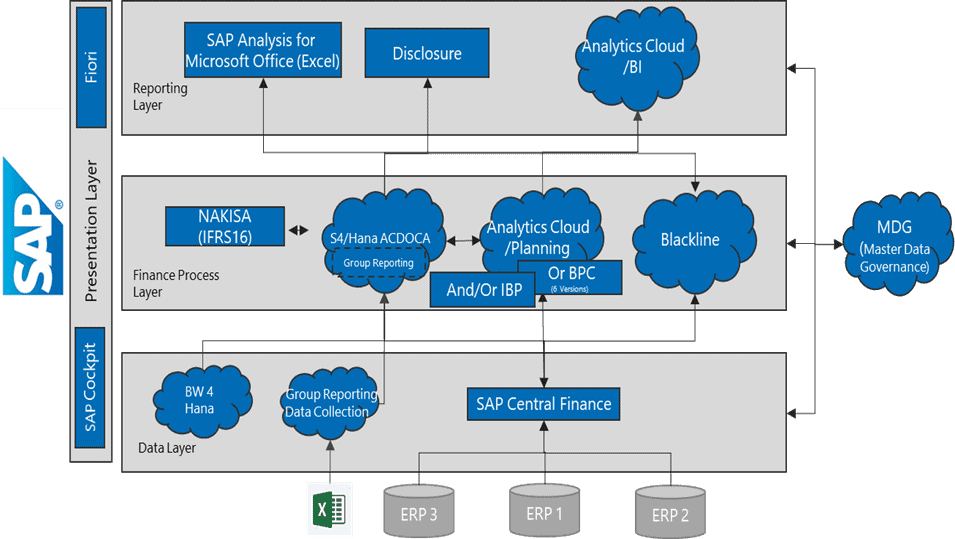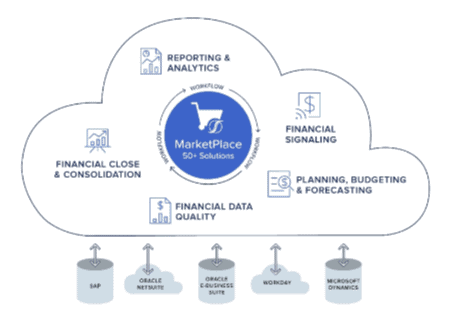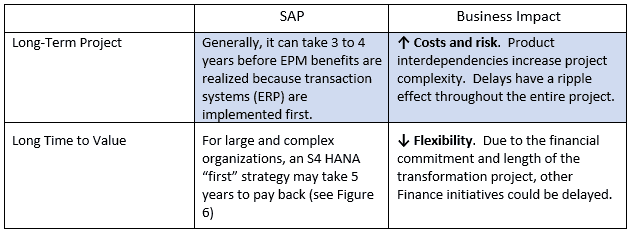As we discussed in Part 1 of this series, Finance teams running legacy SAP solutions are being put in an uncomfortable position. How? Well, despite billions of investment dollars across thousands of customers, SAP is pushing all long-term Finance Transformation through its SAP HANA platform. And with support ending for legacy EPM (and widely used) products such as BPC beginning in 2024, Finance organizations have an important question to answer.
How can Finance organizations drive innovation forward with speed and agility, without compromising critical requirements or getting sucked into a multi-year project?
If your organization uses SAP for EPM, you have three choices:
– Choice 1: Continue with legacy SAP EPM products until their end of life.
– Choice 2: Invest in SAP’s unproven next-generation products, such as Group Reporting, Analytics Cloud (SAC), and maybe Central Finance or some variant hybrid strategy. Note that this strategy requires at least one S/4 HANA Finance instance to support Group Reporting.
– Choice 3: Take control of your Finance Transformation by evaluating alternate EPM strategies with a solution such as OneStream.
Where to begin? No matter where your organization is on its Finance Transformation journey, getting “under the hood” with a thorough due diligence process is critical to understanding how different technologies can impact your Finance team’s user experience. And that is exactly why we’re focusing this post, Part 2 of our blog series on demystifying S/4 HANA and SAP EPM, on key evaluation factors to help you assess how SAP’s transformation strategy might impact your organization.
Key Evaluation Factors
Here are the four common evaluation factors we outlined in our first post:
- Complexity
- Change Management
- Time
- Investment
For those of you evaluating an alternative EPM strategy, we’ll also share some of the feedback from our 130+ SAP ERP customers. Many of them have already replaced SAP BPC, BFC and other legacy products as well.
Let’s dig into each of the key evaluation factors.
Evaluation Factor 1: Complexity
As part of any Finance Transformation, organizations must conquer the complexity inherent within their internal systems to simplify the administration and maintenance of critical processes. Figure 1 illustrates SAP’s multi-product strategy. Each product requires its own resources, skill sets and coordination between respective implementations.

As illustrated in Figure 2, the SAP EPM solution is fractured into multiple products. Each arrow you see is an integration point that must be created and maintained. SAP Analytics Cloud (SAC) is the only native cloud solution – the other solutions were not designed specifically for the cloud.
Thus, a mixture of platforms – which adds risk, cost and complexity – could be needed. Lastly, since each product requires its own skill set, administrators are specific to each product and are not leveraged across solution areas.

In comparison, OneStream (see Figure 3) is a unified corporate performance management (CPM) solution on a single platform. There’s only one integration between your source systems and OneStream, regardless of which EPM processes (e.g., planning, financial close, accounting reconciliations) are part of your solution. Plus, since OneStream is a single product, experienced administrators’ skills can be leveraged across solution domains.

Evaluation Factor 2: Change Management
Change Management (see Figure 4) is another key evaluation factor. Why? Because SAP is asking its customers to commit to a Finance Transformation project that will require significant management resources and oversight over several years across the ERP and EPM technology stack.

By contrast, with OneStream, a project requires only updating your CPM management layer. This step will enable your organization to focus exclusively on innovating and fulfilling the needs of the financial management team and senior executives.
Evaluation Factor 3: Timing
Project timing and time to value are also key evaluation considerations (see Figure 5), especially when evaluating an “ERP first” strategy. Why? Well, right from Day 1, organizations will feel the immediate impacts of cash outflows and mass activity across the entire Finance, Supply Chain and other key functions involved in requirement gathering and project planning.

Impact of ERP Before EPM Investment Strategy
The SAP EPM architecture requires organizations to implement at least one S4/HANA instance before any other work can be done (see Figure 6). In addition, the structures for statutory and management reporting must be built in the S/4 HANA environment as the efficiency of Group Reporting and Central Finance are dependent on S/4 HANA structures. Thus, the initial design portion of the project is lengthened to ensure all EPM and ERP requirements are included in the Global Design.
Why does this matter? Well, those requirements mean you’re looking at a minimum 18-month ERP implementation before work can even begin on the EPM solutions. And if you’re part of a large, global and complex organization, your organization could be looking at a 3- to 4-year ERP implementation before that work can begin.

Comparatively, the OneStream architecture allows you to implement your CPM solution first (see Figure 7). By devoting your efforts to the CPM solution, you will generally see benefits within 6-12 months of starting the project.
And by focusing on the decision-making layer of Finance Transformation, you will address the critical management needs first. This strategy will also provide another benefit: the new chart of accounts would be initially implemented and controlled in OneStream. Once solidified, this structure would then simplify and reduce the design effort of any new ERP system – which will shorten the ERP implementation cycle.
The structure also provides the benefit of extending the timeframe for you to decide on the fate of your current ERP, providing additional runway for you to undertake a more complete analysis of your ERP needs and perform the proper due diligence for that project.

Evaluation Factor 4: Investment
With any project, the actual investment (see Figure 8) should always be a significant consideration. The dollar value of the investment, if great enough, can impact other corporate priorities. Also, as the saying goes, “the larger the investment, the greater the risk.”

Conclusion
Modernizing aging transactional ERP systems and EPM solutions are important and strategic projects that can support finance transformation. And there’s no question that a substantial investment of time and resources is required to upgrade to SAP S/4 for Finance Transformation.
So which do you invest in first – the ERP systems that run the business, or the EPM solutions that help you manage the business?
If you’re a Finance team with immediate needs to drive agility across planning, financial close and other key processes, you must consider the business value of accelerating the Finance Transformation by conquering the complexity of your EPM processes before you embark on an ERP upgrade. You may even find that the value you create will fund your ERP transformation when the time is right.
Learn More
To learn more about why SAP customers are moving to OneStream, read our whitepaper here.
Get Started With a Personal Demo



